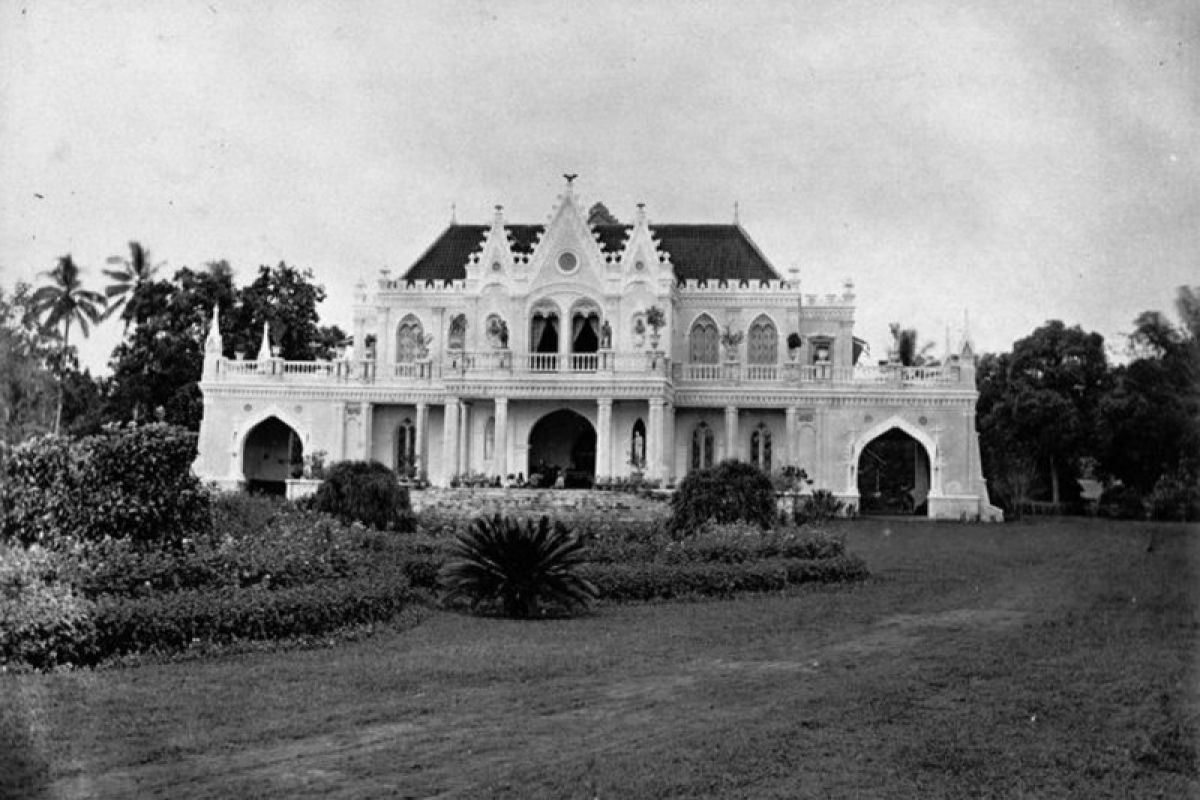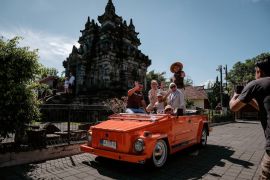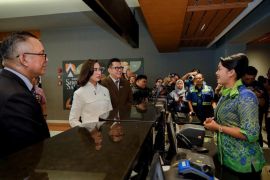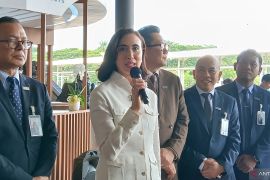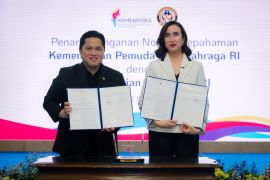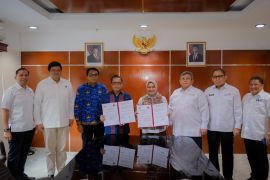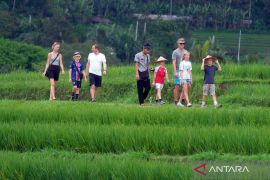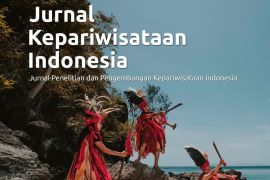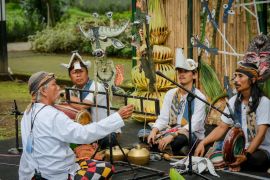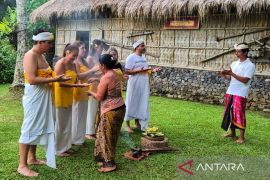There are many special things here. There are Bakoel Koffie and several new culinary tourism locations in CikiniJakarta (ANTARA) - The Taman Ismail Marzuki (TIM) Art Center may well be the most distinguishing feature of Cikini Raya Street in present times. However, Cikini is more than that.
The road that stretches over more or less one km in the center of Jakarta has a long history that goes all the way back to the colonial period.
Cikini has continued to evolve decade after decade, from the 19th century to the 21st century. The modern space around it has also grown and developed.
The historical value of Cikini is something that the Jakarta provincial government, through its Tourism and Creative Economy Office, has been paying attention to.
The city plans to use the road to add value to the development of city tourism, based on the concept of walking tours, which the government has been working on since the end of 2021.
Head of marketing and attraction at Jakarta's Tourism and Creative Economy Office, Hari Wibowo, said that the historical map within Cikini has its own appeal for tourists.
Related news: New Year holidays: Jakarta tourist sites to open for half day
"There are many special things here. There are Bakoel Koffie and several new culinary tourism locations in Cikini," he told ANTARA some time ago.
"There is also Ahmad Soebardjo's house, our first Foreign Affairs Minister. That is also interesting. The house is very large," he said.
The idea for the Cikini Walking Tour emerged from people's interest in conducting tourism in the area, especially since it is supported by adequate infrastructure, he added.
The sidewalks along Cikini Raya road were completed in 2019, and they are complemented with guiding blocks, bollards, park benches, a bus stop, and wayfinding, he said.
Related news: Cikini Walking Tour aims to develop regional-based tourism
With complete facilities for pedestrians available, the concept of a walking tour became more feasible, he added.
To realize this plan, the Tourism and Creative Economy Office is collaborating with regional government-owned enterprise (BUMD) PT Jakarta Tourisindo, Jakarta Experience Board, a tourist agent association, and tour guide community, he informed.
PT Jakarta Tourisindo's event & product specialist, Muhammad Rayhan Islamy, said that the tourism concept will be unveiled as soon as possible.
He said he expects the Cikini Walking Tour to become operational in 2022 and be opened for the general public.
"Because we have done our third trial, we will try to launch it in January. We are also considering the pandemic because this tour (experience) is better to be carried out offline," he said.
Related news: Minister Uno officiates revitalised MURI Gallery in Jakarta
Exploring historical sites in Cikini while walking could become an alternative form of tourism post-pandemic, he added.
This is especially because, for this tourism concept, restrictions could be applied on the number of walking tour participants within a group to avoid crowding, he explained.
The tour guides would not just introduce interesting places, they would also encourage tourists to imagine Cikini's appearance in the past through the route that has been prepared, he said.
The Appearance of Cikini
When Indonesia was still called the Dutch East Indies, Cikini was a special region because it was a part of the Weltevreden, or an area where Europeans primarily lived.
What is interesting, however, is the fact that, during that time, Raden Saleh, a painter maestro and a socialite, was, for a brief decade, the biggest landowner in Cikini.
It is said that the land that Saleh owned spanned from TIM to Cikini Hospital.
Related news: Road To Jakarta Film Week screens four thematic Indonesian movies
In 1852, he designed his own "palace", inspired by the Callenberg castle in Germany, above the land that he purchased after he returned from Europe.
The building still exists today. It is located within Cikini Hospital's complex and has become a cultural heritage.
While there have been small changes ever since it has been restored a few times, Saleh's house still looks majestic.
Built in the Eclectic Neo-Gothic style, the building's trademark is a rose window on the front facade.
Meanwhile, its right and left-wing porticoes have Middle Eastern or Moorish architectural influences.
The most distinguishing feature of its interior is the high-ceilinged hall, surrounded by the second-floor balcony, with skylight lighting that is directly connected to the ground floor.
The halls of European buildings were usually used for ballroom parties.
It was said that the gate to Saleh's house was located in the direction of Cikini Raya, which aligns with the orientation of the building that faces southwest.
Saleh also took kept several types of animals on his land. His love for wildlife was also mirrored in several of his paintings.
Then, in 1862, the garden was donated and converted into a zoo and public park named "Planten En Dierentuin", which was the precursor of Cikini Zoo.
In 1964, the zoo was transferred to Ragunan and, in 1968, the land was transformed into TIM by Governor Ali Sadikin.
At the back of Saleh's home, there are several other antique buildings, such as the Cikini Hospital Chapel, which was built in 1906.
The ornament of this chapel is very closely related to European architecture style. Much like Saleh's house, the chapel has also been designated a cultural heritage.
Related news: West Jakarta prepares to reopen six parks during Level 2 PPKM
After around half a decade, the land no longer belonged to Saleh, and the appearance of Cikini Raya street continued to change with the passage of time.
Moreover, the Dutch East Indies seemed to have prepared the region to support Nieuw-Gondangdia housing (Menteng elite residence).
This can be observed from the establishment of numerous supporting facilities in the form of buildings that are no longer intact, missing, and have been repurposed, including Saleh's park and zoo.
One of the buildings that has not changed much is the Cikini Post Office (Tjikini Post Kantoor). The art deco-style building, which remains in operation to this day, is located at the edge of the street and was constructed in 1920.
Half of Weltevreden existed primarily to fulfill the Europeans' demands and lifestyles.
Around 1920, for instance, the Zwembad Cikini (Cikini Pool) was built here only for Europeans.
There was also the "De Spin" or Laba-Laba, a shop that, during that time, produced leather-based products such as bags and shoes.
The shop remains in operation to this day and has transformed to look no different than other contemporary shops. Currently, Laba-Laba only focuses on shoe and bag repairs.
Not too far from Laba-Laba stands the Eerste School D, which was built by the Dutch East Indies in 1909.
The school was the first education institution for natives in Batavia, but has now been renamed State Junior High School 1 Cikini.
In addition to Eerste School D, there was also the Mayumi Particle People School, now known as Cikini College, which also became popular in the region since it was built during the Japanese occupation period.
Then there are the Tan Ek Tjoan bread factory and Bakoel Koffie café, which were built after Indonesia gained independence, but the history of their products goes back to the 19th century.
Tan Ek Tjoan bread factory started operations in 1955, while Bakoel Koffie café opened in 2002.
However, Tan Ek Tjoan truly began in 1921 in Bogor. In the beginning, it only focused on producing Europeans' daily staple in Bogor, namely gambang bread.
As time went on, Tan Ektjoan started producing a variety of breads that everyone could enjoy.
While the oldest bread factory in Jakarta and Bogor has been relocated to Ciputat, a variety of Tan Ek Tjoan's breads are still sold around Cikini by merchants using bike vendors.
Meanwhile, Bakoel Koffie is an extension of Warung Tinggi that began operations in 1878. Its owner, Liauw Tek Soen, established the first coffee factory in Weltevreden with the name Tek Soen Hoo in 1927.
After Indonesia gained independence, several other legendary buildings were built in the area.
Related news: Jakarta Arts Council opens International Ethnic Music Festival
One such building was Ibu Dibjo's house that became her base for selling tickets for various events in 1963. There is also Hasyim Ning's luxurious home, which stands out the most in Cikini.
There are other buildings that are no longer intact, have disappeared, or have been repurposed, but their products can still be encountered in Cikini.
For instance, the Tjan Jan or Tjanang ice cream shop in 1951 whose ice cream was favored by the first and second presidents' families.
Then, there was the A. Kasoem eyewear shop set up by Atjoem Kasoem in 1956, the first native-owned eyewear shop in Indonesia.
Related news: Jokowi inaugurates Bintang Bano Dam in West Nusa Tenggara
Related news: Government lifts ban on travelers from 14 countries
Editor: Fardah Assegaf
Copyright © ANTARA 2022
